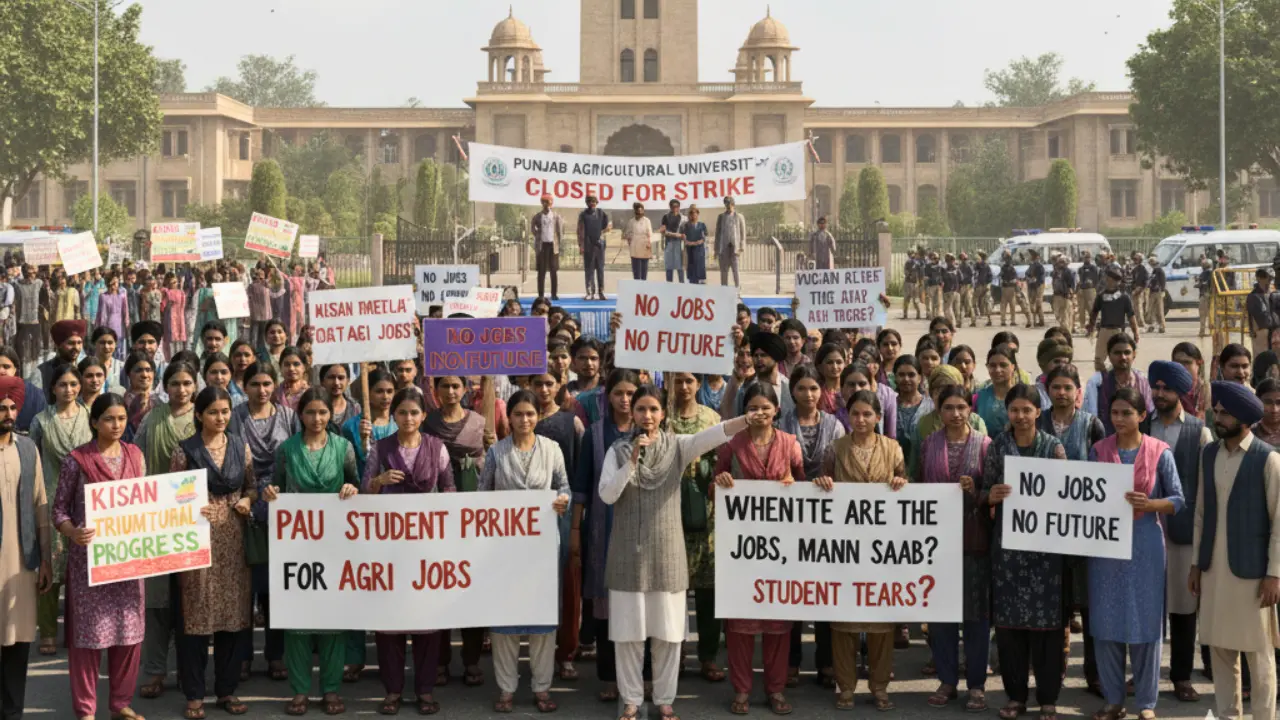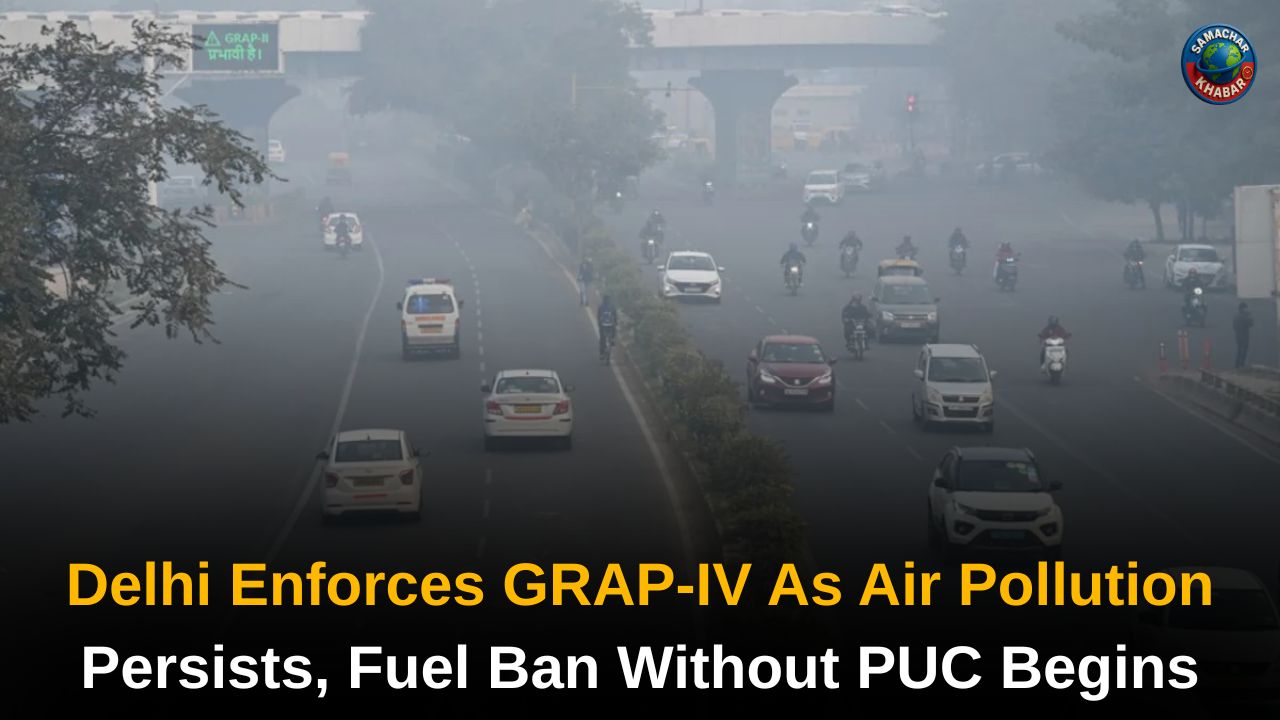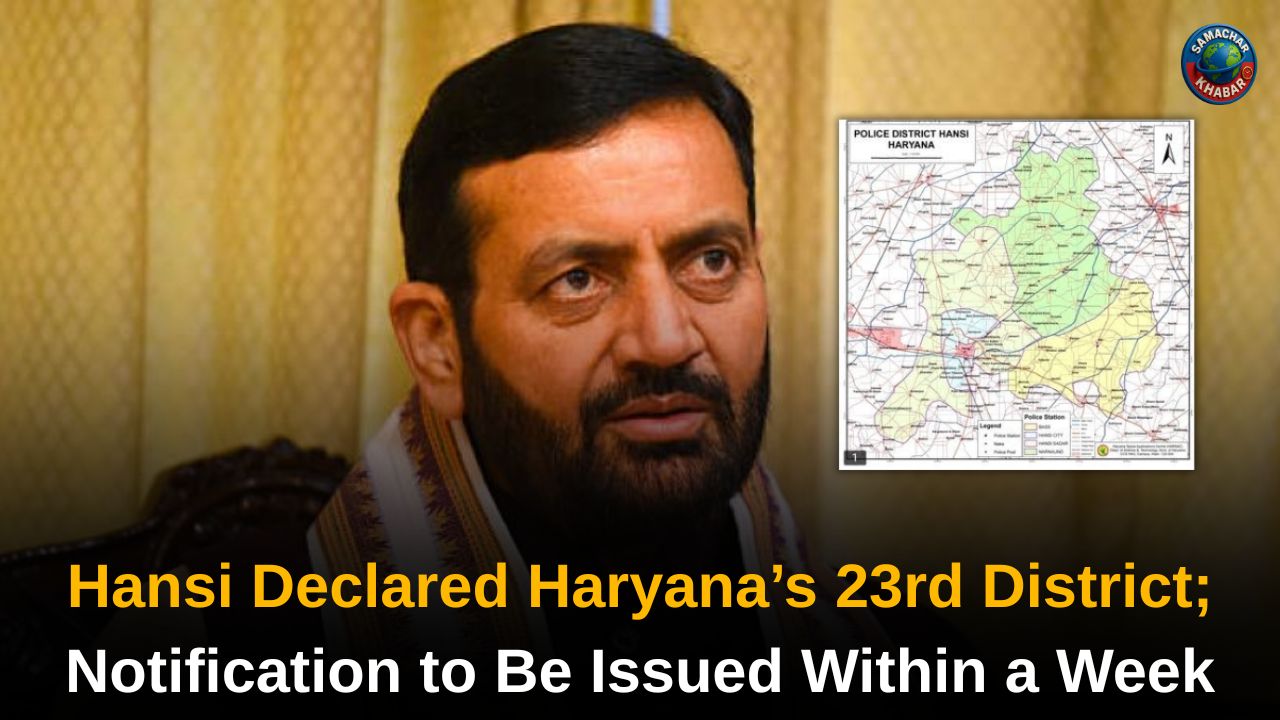PAU Student Protest 2025: On September 27, 2025, as the curtains fell on a resounding two-day Kisan Mela at Punjab Agricultural University (PAU) in Ludhiana—drawing lakhs of farmers to embrace cutting-edge agri-tech—the campus gates bore witness to a stark counterpoint: an escalating student protest entering its third day, with graduates demanding immediate recruitment into thousands of vacant agriculture posts.
This clash of innovation and indignation underscores a deepening crisis in Punjab’s agrarian heartland, where the state’s top agri talent confronts chronic unemployment, testing the AAP government’s three-year-old pledges and spotlighting the fragile bridge between education and opportunity in India’s breadbasket.
Pillars of the Green Revolution: PAU’s Storied Legacy in Punjab’s Agri Landscape
Established in 1962 amid the fervor of India’s Green Revolution, Punjab Agricultural University stands as a beacon of agricultural excellence in Ludhiana, Punjab’s bustling industrial-agri hub. Spanning over 1,500 acres, PAU has pioneered high-yield wheat and rice varieties that propelled India to self-sufficiency, earning it the moniker “Cradle of Punjab’s Agri Boom.” With 11 colleges offering degrees from BSc to PhD in fields like agronomy, horticulture, and veterinary sciences, it boasts an alumni network of over 50,000, many leading global agri-firms and policy desks.
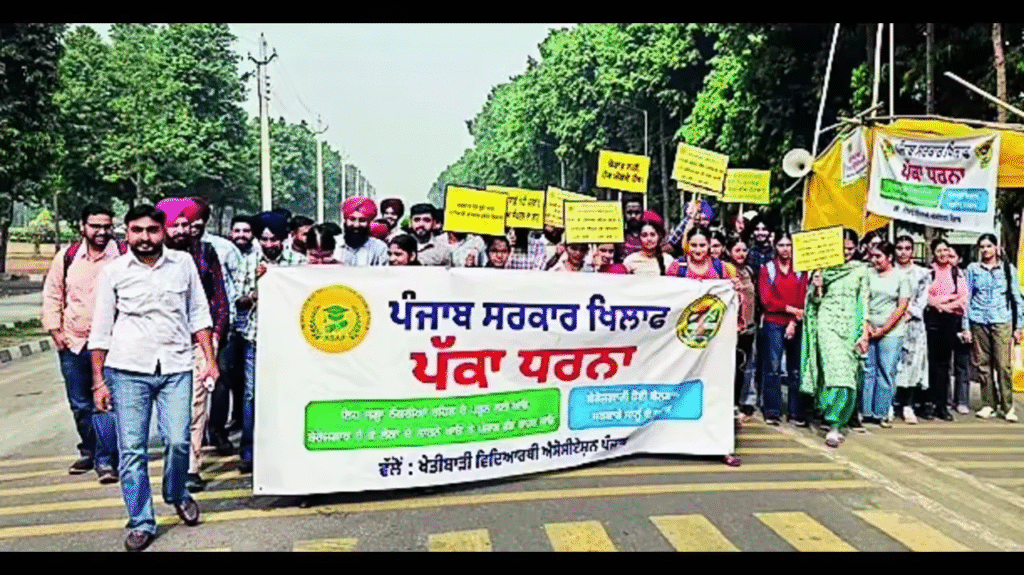
PAU’s reputation extends beyond academia; its extension services, like the Farm Advisory Centers, touch millions of farmers annually, while events such as the Kisan Mela— a staple since 1967—disseminate subsidized seeds and tech demos. Socially influential, PAU has shaped Punjab’s rural ethos, fostering gender-inclusive programs that empowered women in farming and youth entrepreneurship amid climate shifts.
Yet, as Punjab grapples with diversification from water-guzzling paddy, PAU’s role in skilling a new generation for sustainable agri-jobs remains pivotal, making the current student unrest a poignant critique of systemic gaps.
From Campus Cheers to Gate Sit-Ins: The Unfolding Drama of PAU’s Jobs Protest
The spark ignited on September 25, 2025, when over 200 BSc, MSc, and PhD students from PAU, led by the Punjab Agricultural University Students Association (PAUSA) and Agricultural Students Association of Punjab (ASAP), launched an indefinite sit-in at Gate No. 1. 11 Frustration boiled over unkept AAP government vows to recruit agriculture officers, school masters, and allied roles—promises echoed in 17 ministerial meetings with figures like Gurmeet Singh Khuddian and Harpal Cheema, yet yielding zero notifications after three years in power.
By September 26, as the Kisan Mela kicked off with live demos of drought-resistant seeds and drone tech, protesters marched from the library to Thapar Hall, chanting “Save Punjab’s Agri Youth” before settling into a dharna. Eyewitnesses described a surreal scene: mela-goers weaving past placard-wielding grads, some pausing to nod in solidarity. Tensions peaked on September 27 when Punjab Mandi Board Chairman Harchand Singh Barsat, on-site for the event, skipped a promised dialogue, prompting students to block pathways briefly and vow escalation.
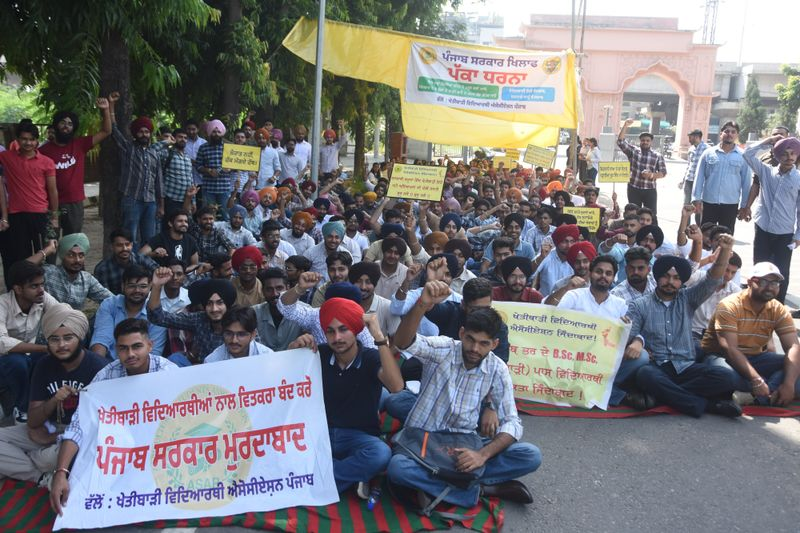
15 ASAP leader Harman Mann captured the raw emotion: “Students from the country’s top agri university were forced to sit on the streets.” 20 No violence ensued, but the parallel veterinary interns’ strike at Guru Angad Dev Veterinary University (GADVASU)—demanding a stipend hike to ₹24,310—amplified the chorus, with interns boycotting duties while aiding mela visitors voluntarily.
Government Assurances and Stalemate: Updates from the Frontlines of PAU Unrest
As of September 28, 2025, Punjab’s administration has offered no formal concessions, with Chief Minister Bhagwant Mann’s office silent on the demands amid monsoon recovery priorities. University Vice-Chancellor Dr. (retd) PS Tangri mediated a late September 27 huddle, securing a pledge for guest meetings on September 28, but students dismissed it as “delay tactics.” 22 The Agriculture Department cited fiscal strains from ₹2,000 crore flood damages, yet a state audit reveals 4,500+ vacancies in agri roles—1,200 ADOs, 800 ASIs, and hundreds in Mandi and Horticulture—idling since 2022.
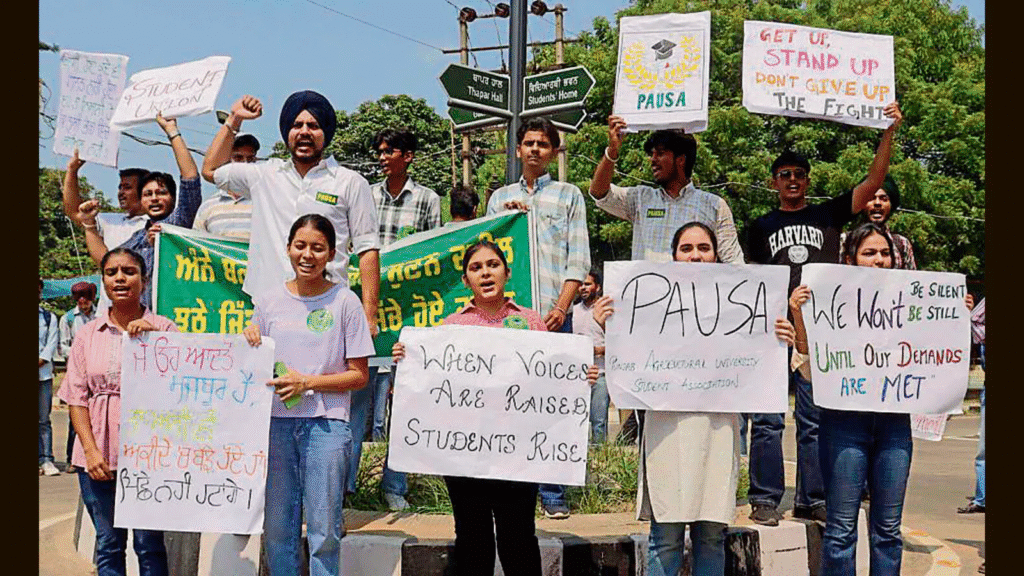
No injuries or medical emergencies stem from the protest, though students report fatigue from round-the-clock vigils; campus health services provided hydration kits. An internal PAU inquiry into protest logistics is underway, per registrar notes, while the Punjab Human Rights Commission flagged it for monitoring to ensure peaceful conduct. Broader probes into recruitment delays, hinted at by opposition queries in the Vidhan Sabha, could surface by mid-October.
Echoes of Solidarity and Skepticism: Reactions Pour In from Punjab’s Agri Circles
The protest has ignited a spectrum of responses, blending empathy with critique. At the Kisan Mela, farmers—many PAU alumni parents—halted stalls to hear pleas, with one elder from Sangrur sharing, “These kids know our fields better than us; denying them jobs starves the future.” 21 Industry voices, including Punjab’s Krishi Vigyan Kendras, urged swift hires, warning of a “brain drain” as 30% of 2024 PAU grads eye NRI jobs.
Also Read: Ladakh Gen Z Protests: Violence, Statehood Demand, and Sonam Wangchuk vs Centre
Politically, Shiromani Akali Dal chief Sukhbir Singh Badal amplified the cause on X, posting: “Punjab’s agriculture department is crippled… This deprives farmers of key services and graduates of deserved jobs.” 0 Ex-Olympian Pargat Singh echoed support, while AAP youth wings countered with “budget constraint” defenses on social media. Fan-like devotion from student networks trended #PAUStudentProtest, garnering 50,000 views, though some online trolls labeled it “anti-farmer disruption” amid mela festivities.
Seeds of Doubt: How the Protest Shadows PAU’s Prestige and Student Trajectories
For PAU, a protest on its hallowed grounds risks tarnishing its image as a harmonious agri nexus, potentially deterring donor funds from bodies like ICAR, which pumped ₹150 crore last year. Yet, it could galvanize reforms, positioning the university as a catalyst for policy change. For students, the stakes are existential: Harman Mann noted 70% unemployment among agri grads, with many deferring PhDs or migrating, eroding Punjab’s talent pool and stalling ambitions in a sector vital for the state’s 20% GDP.
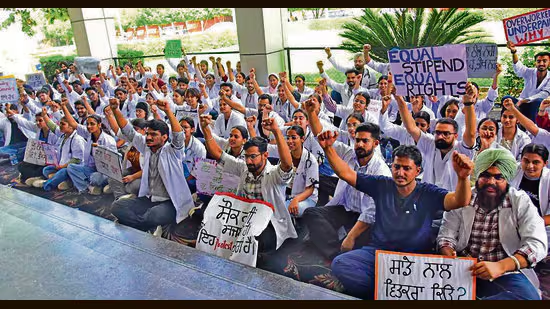
No direct hit to PAU’s political clout—it’s apolitical by charter—but the unrest amplifies calls for advisory roles in state agri policy, where grads could influence diversification amid falling groundwater tables.
Ripples in the Fields: Cultural and Societal Undercurrents of Punjab’s Agri Youth Crisis
This standoff transcends Ludhiana’s gates, mirroring Punjab’s cultural pivot from martial farmer pride to educated idleness, where Jatt youth—once land lords—now chase elusive white-collar agri gigs. Socially, it spotlights gender disparities: only 15% of protesters are women, reflecting barriers in rural hiring, and exacerbates mental health strains, with a 2024 PAU survey logging 25% depression rates among unemployed grads.
Culturally, amid Lohri bonfires and Baisakhi joys, the protest evokes historical satyagrahas, urging a societal rethink: from glorifying “big farm” machismo to valuing scientific stewardship, fostering inclusive growth in a state where agri employs 60% yet youth aspire beyond plows.
Data-Driven Demands: Experts Weigh In on Vacancies and Viability
Agri economists like Dr. Rajinder Kaur from PAU’s Economics Department peg the vacancy toll at ₹500 crore annual losses in extension services, with a 2025 ICAR report showing Punjab’s agri productivity lagging 10% due to understaffing. 12 Policy analyst Ashok Gulati argues, “Filling these posts isn’t charity—it’s investment; each ADO can boost yields by 5-7% via tech adoption.” Data underscores urgency: 12,000 agri grads enter Punjab’s market yearly, but only 2,000 jobs materialize, per NSSO stats.
Experts advocate hybrid models—public-private hires via MARKFED—warning prolonged delays could spike migration, echoing the 1980s brain drain. For resolution, they eye a tripartite forum by November, blending student input with fiscal realism.
Harvesting Humility: Purposeful Pursuit Amid PAU’s Call for Equity
In the quiet resolve of PAU’s protesters, echoes of deeper wisdom surface, as Sant Rampal Ji Maharaj’s Satgyan—drawn from Almighty Kabir’s verses and Gita’s essence—illuminates the soul’s true till: not fleeting posts, but eternal dignity in service to the divine order. He teaches that life’s purpose unfolds through responsible leadership, where ambition bows to karma’s balance—honoring the laborer’s hand as sacred, much like the farmer who sows without hoarding the yield.
For these students, the dharna becomes a forge: a lesson in patient grace, urging governance not as power’s grab but as stewardship for the collective soul. In Satgyan’s light, filling vacancies transcends policy—it’s reclaiming human worth, guiding Punjab’s youth from jobless shadows to enlightened fields where true leadership blooms in humility and shared prosperity.
FAQs: PAU Jobs Protest 2025
What triggered the PAU student protest in September 2025?
Unfilled government promises to recruit agri graduates into 4,500+ vacant posts in departments like Agriculture and Mandi Board, despite 17 ministerial meetings since AAP’s 2022 rise.
What is Punjab Agricultural University’s role in India’s agri sector?
Founded in 1962, PAU led the Green Revolution with high-yield crops; today, it trains 5,000+ students yearly, runs extension services for millions, and hosts events like Kisan Mela for tech dissemination.
What are the key demands of PAU protesters?
Immediate notifications for roles like ADOs, ASIs, and market secretaries; parallel GADVASU interns seek stipend hikes to ₹24,310/month.
How has the Punjab government responded to the PAU strike?
No concessions yet; university officials promised guest meetings on September 28, but fiscal excuses prevail amid flood recovery.
What impact could the PAU protest have on Punjab’s agriculture?
It risks service gaps costing ₹500 crore yearly, but could spur reforms, retaining talent crucial for diversification and climate-resilient farming.
Why does the PAU jobs protest amid Kisan Mela matter for Punjab?
It contrasts agri innovation with youth despair, highlighting systemic unemployment that threatens the state’s 20% agri-GDP and farmer support networks.

